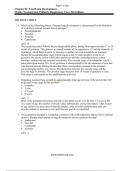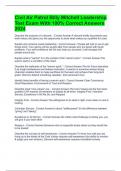NURSINGTB.COMChapter 01: Fetal Lung Development Walsh: Neonatal and Pediatric Respiratory Care, 5th Edition MULTIPLE CHOICE 1. Which of the following phases of human lung development is characterized by the formation of a capillary network around airway passages? a. Pseudoglandular b. Saccular c. Alveolar d. Canalicular ANS: D The canalicular phase follows the pseudoglandular phase, lasting from approximately 17 to 26 weeks of gestation. This phase is so named because of the appearance of vascular channels, or capillaries, which begin to grow by forming a capillary network around the air passages. During the pseudoglandular stage, which begins at day 52 and extends to week 16 of gestation, the airway system subdivides extensively and the conducting airway system develops, ending with the terminal bronchioles. The saccular stage of development, which takes place from weeks 29 to 36 of gestation, is characterized by the development of sacs that later become alveoli. During the saccular phase, a tremendous increase in the potential gas-exchanging surface area occurs. The distinction between the saccular stage and the alveolar stage is arbitrary. The alveolar stage stretches from 39 weeks of gestation to term. This stage is represented by the establishment of alveoli. 2. Regarding postnatal lung growth, by approximately what age do most of the alveoli that will be present in the lungs for life develop? a. 6 months b. 1 year c. 1.5 years d. 2 years ANS: C Most of the postnatal formation of alveoli in the infant occurs over the first 1.5 years of life. At 2 years of age, the number of alveoli varies substantially among individuals. After 2 years of age, males have more alveoli than do females. After alveolar multiplication ends, the alveoli continue to increase in size until thoracic growth is completed. 3. The respiratory therapist is evaluating a newborn with mild respiratory distress due to tracheal stenosis. During which period of lung development did this problem develop? a. Embryonal b. Saccular c. Canalicular d. Alveolar ANS: A NURSINGTB.COMNeonatal and Pediatric Respiratory Care 5th Edition Walsh Test Bank
Page 1 of 134
WWW.NURSYLAB.COMPage 1 of 238
WWW.NURSYLAB.COM NURSINGTB.COMThe initial structures of the pulmonary tree develop during the embryonal stage. Errors in development during this time may result in laryngeal, tracheal, or esophageal atresia or stenosis. Pulmonary hypoplasia, an incomplete development of the lungs characterized by an abnormally low number and/or size of bronchopulmonary segments and/or alveoli, can develop during the pseudoglandular phase. If the fetus is born during the canalicular phase (i.e., prematurely), severe respiratory distress can be expected because the inadequately developed airways, along with insufficient and immature surfactant production by alveolar type II cells, give rise to the constellation of problems known as infant respiratory distress syndrome . 4. Which of the following mechanisms are responsible for the possible association between oligohydramnios and lung hypoplasia? I. Abnormal carbohydrate metabolism II. Mechanical restriction of the chest wall III. Interference with fetal breathing IV. Failure to produce fetal lung liquid a. I and III only b. II and III only c. I, II, and IV only d. II, III, and IV only ANS: D Oligohydramnios, a reduced quantity of amniotic fluid present for an extended period of time, with or without renal anomalies, is associated with lung hypoplasia. The mechanisms by which amniotic fluid volume influences lung growth remain unclear. Possible explanations for reduced quantity of amniotic fluid include mechanical restriction of the chest wall, interference with fetal breathing, or failure to produce fetal lung liquid. These clinical and experimental observations possibly point to a common denominator, lung stretch, as being a major growth stimulant. 5. What is the purpose of the substance secreted by the type II pneumocyte? a. To increase the gas exchange surface area b. To reduce surface tension c. To maintain lung elasticity d. To preserve the volume of the amniotic fluid ANS: B The primary role of mammalian surfactant is to lower the surface tension within the alveolus, specifically at the air –liquid interface. This allows the delicate structure of the alveolus to expand when filled with air. Without surfactant, the alveolus remains collapsed because of the high surface tension of the moist alveolar surface. Surfactant is composed predominantly of an intricate blend of phospholipids, neutral lipids, and proteins. 6. Which of the following tests of the amniotic fluid have been shown to be sensitive indicators of lung maturity? a. Levels of prednisone b. Levels of epidermal growth factor c. Levels of prostaglandins d. Levels of phosphatidylglycerol and phosphatidylcholine ANS: D NURSINGTB.COMNeonatal and Pediatric Respiratory Care 5th Edition Walsh Test Bank
Page 2 of 134
WWW.NURSYLAB.COMPage 2 of 238
WWW.NURSYLAB.COM NURSINGTB.COMOf clinical relevance during late gestation, analysis of amniotic fluid for the concentration of phosphatidylglycerol and phosphatidylcholine has been shown to be a sensitive indicator of the state of fetal lung maturity. 7. Approximately how much fetal lung fluid is secreted daily? a. About 150 to 200 ml b. About 250 to 300 ml c. About 350 to 400 ml d. About 450 to 500 ml ANS: B Fetal lungs are secretory organs that make breathing-like movements but serve no respiratory function before birth. They secrete about 250 to 300 ml of liquid per day. 8. The lung bud emerges from which of the following structures? a. The pharynx b. The foregut c. The mesenchyme d. The tubular epithelium ANS: A The embryonal phase includes primitive lung development and is generally regarded to encompass the first 2 months of gestation. The lung begins to emerge as a bud from the pharynx 26 days after conception. NURSINGTB.COMNeonatal and Pediatric Respiratory Care 5th Edition Walsh Test Bank
Page 3 of 134
WWW.NURSYLAB.COMPage 3 of 238
WWW.NURSYLAB.COM NURSINGTB.COMChapter 02: Fetal Gas Exchange and Circulation Walsh: Neonatal and Pediatric Respiratory Care, 5th Edition MULTIPLE CHOICE 1. Which of the following embryonic germ layers gives formation to the respiratory system? a. Endoderm b. Mesoderm c. Ectoderm d. Periderm ANS: A The respiratory system —pharynx, lungs, and epithelial lining of the trachea and lungs —originates in the endoderm. Refer to Box 2-1 in the textbook to see the list of various tissue systems found in the three embryonic layers. 2. What is the function of Wharton’s jelly inside the um bilical cord? a. To help provide nutrition to the fetus b. To prevent the vessels inside the cord from kinking c. To help protect the fetus d. To regulate the temperature between the fetus and the mother ANS: B Wharton’s jelly, a gelatinous substance inside the umbilical cord, helps protect s the vessels of the fetus and may prevent the cord from kinking. 3. Which of the following organs is considered to be the first complete form? a. Heart b. Brain c. Lungs d. Kidneys ANS: A The heart is considered to be the first complete organ formed. By 8 weeks of gestation, the normal fetal heart is fully functional, complete with all chambers, valves, and major vessels. 4. A pregnant woman is coming for an early prenatal evaluation and wants to know if she can listen to the baby’s heartbeat. How early can the fetal heartbeat be detected? a. Day 8 b. Day 22 c. Day 45 d. Day 60 ANS: B By day 22, cardiac contractions are detectable and bidirectional tidal blood flow begins. 5. Which of the following anatomic structures are fetal shunts? I. Foramen ovale II. Sinus venosus III. Ductus venosus NURSINGTB.COMNeonatal and Pediatric Respiratory Care 5th Edition Walsh Test Bank
Page 4 of 134
WWW.NURSYLAB.COMPage 4 of 238
WWW.NURSYLAB.COM





